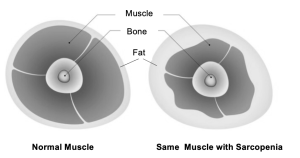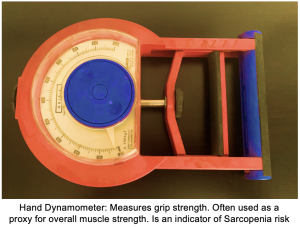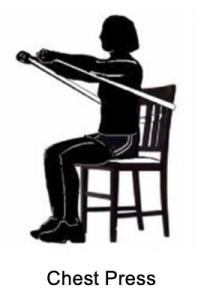Introduction
Sarcopenia may well be one of the most important things you have never heard of.
It is a strange sounding word to many people – not used much outside research or medical/rehab communities. However it describes something that impacts everyone to varying degrees as they get older.
So – what exactly IS Sarcopenia?
“Sarcopenia” is a medical term that refers to the loss of muscle mass and muscle “quality” that happens to everyone as they get older. It comes from the combination of 2 Greek words, “Sarco-” (meaning “Flesh”) and “-penia” (meaning “loss”). Not surprisingly, this condition also results in a loss of strength and loss of physical function.

Maybe you have noticed this happening with yourself – or with some of your older friends and family; everyday activities that were once taken for granted become more and more of an effort (climbing stairs, getting out of chairs, walking briskly, carrying shopping, etc.). For some of us these become impossible – or so difficult they are avoided altogether (“Can I help you out with the groceries sir?”)
What does Sarcopenia look like today?
In the US, up to 15% of adults in their 60s, and 50% of adults in their 80s (About 18 million people) have been clinically diagnosed with sarcopenia (Burton, 2010)
However, this is not the whole story, because these numbers refer only to people who have actually had their muscle mass assessed by hi-tech methods with results determined to be severe enough to impact their quality of life.
NOTE: These methods are too complex to go into here, but standard equations exist to estimate/measure muscle mass, using either anthropometric methods or advanced technologies such as DEXA, BIA or MRI.
More importantly, Research has determined that Sarcopenia is best thought of not as a one-off event, but a gradual Process that impacts far more people than just those who have received a post-measurement diagnosis.
A recent international Sarcopenia consensus conference stated that
… there are grades of Sarcopenia that range from sub-clinical to frailty
NOTE: “Subclinical” means there are no obvious signs of physical or functional decline. “Frailty” means there are obvious signs of physical or functional decline, including muscle weakness and increased risk or occurrence of falls.
Sarcopenia by the Numbers
Sarcopenia sneaks up on all of us to varying degrees and is still mainly regarded as an “Aging Issue”. However, when viewed as a Process (“range”), it’s a different story.
By age 40, many of us have already begun to lose muscle mass – for some this can be as much as 6% per decade. Thus, a typical 85-year-old will have a muscle mass that is three quarters of what it was when they were 45 years old (Janson, 2010)
Strength losses are even greater: up to 15% per decade between 30 and 70 yrs of age, and up to 30% per decade thereafter (Keller, 2019).
Physical function losses parallel these findings: in recent surveys of adults 65+, as many as 70% report difficulty in performing a wide range of everyday activities. (Khalili, 2024).
All this research tells us that, if untreated, losses due to Sarcopenia are a major cause of late-life disability. This includes potentially serious consequences ranging from significant functional disability and reduction in Quality of Life, as well as increased morbidly and mortality (Brotto, 2012)
Identifying Sarcopenia
A Recent International Conference on Sarcopenia reported that the risk, or presence of Sarcopenia can be tested for using three measures: low muscle mass, low muscle strength, and low physical function.


However, because strength and physical function are major components of Sarcopenia (and are far easier to obtain than hi-tech assessments of muscle mass), a low score on these two tests alone can indicate a risk of Sarcopenia. If needed, this can lead to a diagnostic assessment of muscle mass.
So … we have Bad News, and we have Good News
Bad News: As described above, Sarcopenia-related losses are inevitable for all of us as we get older. It’s all part of the Circle of Life.
Good News: Research has shown that almost anyone can reduce or delay the impact of Sarcopenia, enabling most of us to remain healthy, active, and independent longer.
How to do this?
Strength Training and Sarcopenia
Strength training (“Resistance Exercise”) has been shown to increase strength at any age, and it is now acknowledged as the most effective method for the treatment and/or prevention of Sarcopenia. A recent review on Sarcopenia reported that
“… resistance exercise is the standard non-pharmacological treatment approach for sarcopenia with significant positive evidence.”
More than a decades amount of Research has consistently reported the safety and fundamental value of strength training for most adults of any age – even at lower intensities. Increasing strength can increase both muscle mass and physical function (Brotto, 2012), even for once a week training
AND … there is even more good news …
Strength increases happen relatively quickly. Significant strength and functional gains in older adults have also been reported with programs of only once per week (Taaffe, 1999). More generally, Research has shown that 15-20 minutes of moderate intensity strength training 2-3 times per week for as little as 8 weeks can increase muscle mass by ~10%, strength by as much as 113%, and physical function by ~11% (Keller, 2019).
In lifestyle terms therefore, almost a decade of age-induced loss of muscle mass, strength and function, can be regained over a period of ~8 weeks, with a regular and appropriately designed program of strength training.
Strength is the antidote for frailty and low quality of life
Also, you don’t have to go to a gym and work out with dumbbells and barbells. Research has shown that a home based program using rubber bands/Tubing (“Elastic Resistance”) is just as effective. More Research information on this type of exercise, will appear in a later post


TAKE HOME MESSAGE:
Research has shown that
- Sarcopenia inevitably develops as we age
- Strength training can slow the Process of Sarcopenia and/or reduce the risk of a Sarcopenia diagnosis
- Increased muscle strength, muscle mass and physical function can be achieved with a home based elastic resistance training program.
All this is possible without the use of drugs or pharmaceuticals.
NOTE: If you are interested in obtaining more information on Sarcopenia or if you feel that Research could Matter to some aspect of your business or lifestyle…
Email Dr. Phillips directly at wphillips@syfound.com – or use our Contact Page
